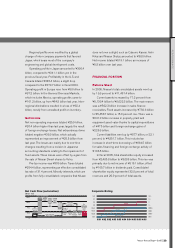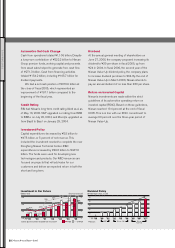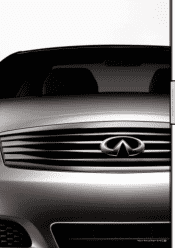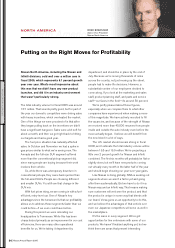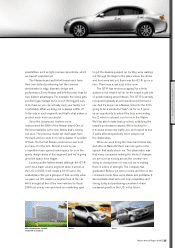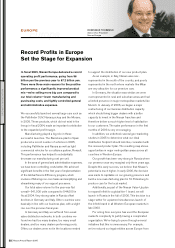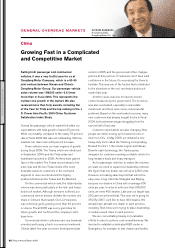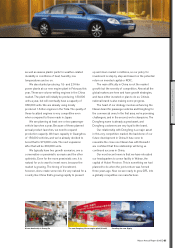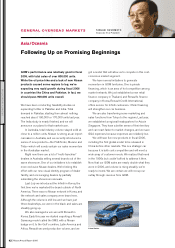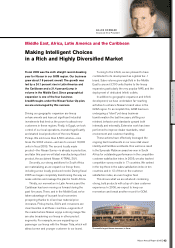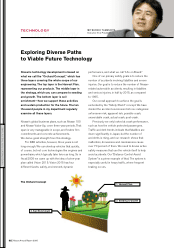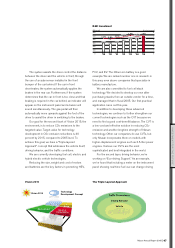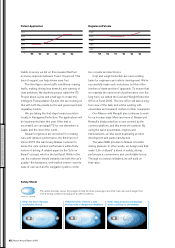Nissan 2006 Annual Report Download - page 40
Download and view the complete annual report
Please find page 40 of the 2006 Nissan annual report below. You can navigate through the pages in the report by either clicking on the pages listed below, or by using the keyword search tool below to find specific information within the annual report.
EEuurrooppee
Nissan Annual Report 2005
38
In fiscal 2005, Nissan Europe delivered a record
operating profit performance, going from 56
billion yen the previous year to 67.2 billion yen.
There were three main reasons for the positive
performance: a significantly improved product
mix—we’re selling more big cars compared to
our total volume—lower manufacturing and
purchasing costs, and tightly controlled general
and administrative expenses.
We successfully launched several large cars such as
the Pathfinder SUV, Navara pickup and the Murano,
in 2005. These products, which did not exist in the
lineup in fiscal 2004, made an important contribution
to the expanded profit margin.
Manufacturing played a big role in these
successful launches. The Barcelona plant in Spain
produced a record number of vehicles in 2005,
including Pathfinder and Navara as well as light
commercial vehicles for our alliance partner, Renault.
This performance has helped to substantially
decrease our manufacturing cost per unit.
In the area of general and administrative expenses,
we have been controlling costs better. We achieved
significant benefits in the first year of implementation
of the Global Service Efficiency program, which
involves offshoring non-core tasks and simplifying and
streamlining many of our support processes.
Our total sales volume for the year was flat
overall—541,000 units compared to 544,000 in
fiscal 2004. Very strong sales in Russia offset
declines in Germany and Italy. Other countries were
basically in line with our business plan, with a slight
rise over the previous fiscal year.
In Germany and Italy we suffered from weak
sales distribution networks. In both countries we
found we had too many dealers, too many small
dealers, and too many dealers performing poorly.
Often, our dealers were not in the locations needed
to support the distribution of our new product plan.
As an example, in Italy, Nissan was over-
represented in the south of the country, and poorly
represented in the north where markets like Milan
are very attractive for our premium cars.
In Germany, the situation was similar: we were
overrepresented in rural and suburban areas and had
a limited presence in major metropolitan markets like
Munich. In January of 2006, we began a major
restructuring of our German distribution capacity
which should bring bigger dealers with a better
capacity to invest in the Nissan franchise and
therefore deliver a much higher level of satisfaction
to our customers. The sales performance in the first
months of 2006 is very encouraging.
In addition, we undertook several geo-marketing
studies in 2005 to determine what our ideal
distribution footprint should look like, consistent with
the renewed product plan. The resulting map shows
opportunities in major metropolitan areas across all
countries in Western Europe.
Our growth has been very strong in Russia where
our presence was very marginal only three years ago.
Despite this early success, we believe that Nissan’s
potential is much higher. In early 2006, the decision
was made to capitalize on our growing presence and
build a new manufacturing plant in St. Petersburg to
produce cars for the local market.
Additionally, as part of the Nissan Value-Up plan
to expand Infiniti to a global tier-1 brand, we will
launch in Russia in the fall of 2006. This decision is a
stage-setter for a planned simultaneous launch of
the Infiniti brand in all Western European markets in
late 2008.
For a long time everyone has used the European
market’s complexity to justify having a complicated
organization. We’re trying to prove through several
initiatives that this is unnecessary. For example,
we've reduced our legal entities across Europe from
EUROPE
Record Profits in Europe
Set the Stage for Expansion
DOMINIQUE THORMANN
Senior Vice President
Nissan Europe
GROWTH MOMENTUM



